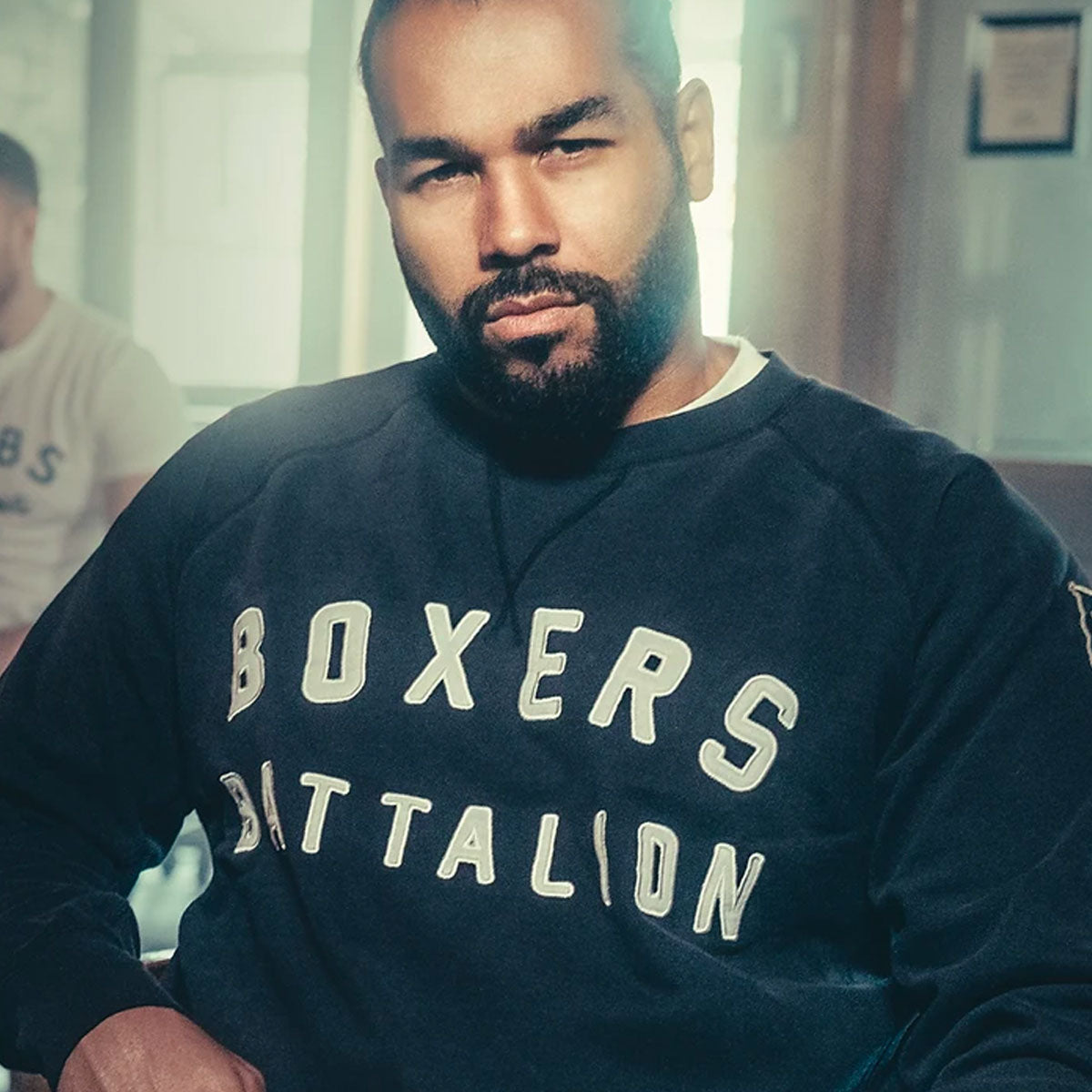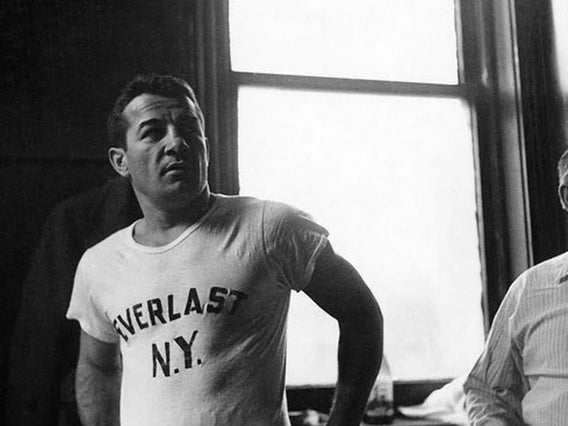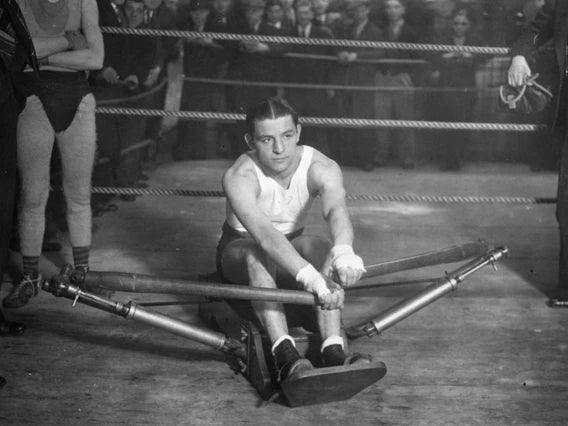By Paul Zanon

“48 DIE IN BLAZING FRENCH AIR-LINER
MOUNTAIN CRASH IN THE AZORES
GINETTE NEVEU AND MARCEL CERDAN AMONG THE VICTIMS”
The Guardian, London, 29 October 1949
People spend far too much time talking about how a person died as opposed to how they lived. Marcel Cerdan perished on 28 October 1949 whilst on board an Air France Constellation vessel which crashed into a 3,600 feet peak on the island of São Miguel in the Portuguese Azores. He was only 33 years old. Now let’s talk about the incredible life he lived as opposed to an ill fated last few minutes which tell us nothing about possibly France’s best ever sportsperson.
Cerdan was born on 22 July 1916 in Sidi Bel Abbès, Algeria to French parents Antonio Cerdan and Asunción Cascales and soon relocated to Morocco a few years after his birth. In addition to being a labourer and butcher, his father also started to promote amateur boxing shows, which young Marcel and two of his older brothers fought on.
Cerdan turned professional on 10 November 1934 at the age of 18, in the Moroccan city of Meknes, beating Marcel Bucchianeri on points. Twenty eight out of his next 35 contests were fought in Morocco, so it came as no surprise that he soon earned himself the moniker of ‘The Casablanca Clouter.’
On his 36th outing Cerdan made his debut on European soil beating Louis Jampton on points at the Salle Wagram, Paris, France. After defeating his next five opponents in less than three months, Cerdan fought Omar Kouidri on 21 February 1938 for the French welterweight title in Casablanca, gaining victory via a clear-cut points decision.
Over the next nine months Cerdan fought a further 10 times, defending his welterweight strap twice and gaining the attention of the world media as his unbeaten run extended to 44-0. In his 45th contest, on 9 January 1939 the Algerian born Frenchman travelled to the Earls Court Empress Hall, London taking on Harry Craster, who came with a mediocre record of 25-22-10. What should have been an easy win turned out to be his fist blemish on an otherwise perfect record as the contest was halted in the fifth round after Cerdan was disqualified for landing a low blow.

Totally undeterred by the loss, Cerdan was back in the ring 12 days later in Algeria, beating Italian Ercole Buratti over 10 rounds. After clocking up a further four victories in four months, on 3 June 1939 Cerdan took on ‘The Milan Panther,’ Saverio Turiello for the Italian’s European welterweight crown. Cerdan had actually beaten Turiello four months prior, but the belt had not been on the line on that occasion. Despite a home advantage of fighting at the Velodromo Vigorelli, Milan, Cerdan defeated him again and in doing so became the new welterweight champion of Europe.
As Cerdan was winning battles inside the ring, World War II was erupting outside of it. Shortly after the Vigorelli bout, Cerdan enlisted in the French Navy and consequently didn’t fight in 1940, by which time Germany, who were now occupying France, had disbanded the unit he was serving in.
Jumping back into the square ring in January 1941, Cerdan added a further 17 wins to his record, before lightning struck twice. On 15 August 1942, Cerdan was on route to certain victory, having knocked Victor Buttin down five times, when he was disqualified for a low blow in the eighth round. Cerdan’s record now read 67-2, which was still incredibly impressive.
Six weeks later, Cerdan put his European welterweight title on the line in Paris against Spaniard Jose Ferrer, who came with a solid record of 25 wins, two losses and four draws. Unfortunately for Ferrer, Cerdan obliterated him, knocking him down five times and sealing the deal in only one minute and 25 seconds of the first round. The win vexed German war officials so much that Cerdan felt compelled to flee to his safe haven of North Africa where he won his next 11 fights. Two names of note during those 11 fights include Bulldog Milano and James Toney. Bulldog Milano, just because it’s a great name, albeit he only fought twice as a professional and was knocked out both times and the other, James Toney simply because the later and vastly more successful namesake makes for a great fantasy fight matchup against Cerdan at middleweight.
During this time he also competed in a boxing tournament called the Inter-Allied competition in Algeria, winning at welterweight and then a few months later walking away victorious in the middleweight category in Italy. With a vast number of American soldiers based in Italy, Cerdan made enough noise to gain the attention of the promoters and fighters from the other side of the pond. As World War II came to an end, Cerdan returned to fight on French soil, winning six fights in 1945, including a win against Assane Diouf on 30 November for the French middleweight title.
1946 proved to be a springboard year for Cerdan, fighting eight times in four countries, including making his debut in America against Georgie Abrams on 16 December 1946 at Madison Square Garden. The Virginian born middleweight had challenged reigning world champion, Tony Zale a year prior, putting The Man of Steel on the seat of his pants for a nine count in the opening round. Despite not beating Zale, Abrams gave a very good account of himself in a sensational fight, losing closely on points over 15 rounds. Standing at 5ft 6 ½ inches, Cerdan gave away almost three inches to the tough American, but through raw talent, power and determination, he secured a strong points victory. The win over Abrams sent a message out to the division that he was ready to take on the best, including Zale.
The year after, Cerdan was on the road again engaging in meaningful fights to increase his visibility and gain that all essential traction to move him closer to a world title shot. Fighting five times in 1947 he won the European middleweight crown in France knocking out Leon Fouquet in the opening round, then nine days later travelled to the UK to knock out Bert Gilroy in four. Six weeks later he knocked out Harold Green at Madison Square Garden in the second session, followed by a first round demolition of Billy Walker in Montreal, Canada, before finishing the year back in the USA, dishing out a one sided beating over 10 rounds against Anton Raadik in Chicago. That’s a helluva road trip.
In the first three months of 1948, Cerdan defended his European middleweight title twice and knocked out 24-1 Texan prospect LaVern Roach in the eighth round at Madison Square Garden. Two months later, Cerdan now boasting a 106-2 resume travelled to Cyrille ‘Tarzan’ Delannoit’s Belgian backyard to defend his European strap. Unfortunately, Cerdan was the victim of a home decision, incurring his third loss, but this time on points instead of disqualification.
Not one to rest on his laurels, six weeks later Cerdan travelled back to Belgian and beat up Delannoit over 15 rounds, including two knockdowns, to reclaim his title. The Moroccan Bomber had now propelled himself into a position to challenge for the middleweight world title.
On 21 September 1948, Cerdan challenged Tony Zale for his National Boxing Association world middleweight title at the Roosevelt Stadium, Jersey City. From the opening stanza, Cerdan, the bookies underdog, suffocated Zale with his attacks, work rate and raw boxing skill. At the end of the eleventh round of a cracking fight, Cerdan detonated a left hook to Zale’s jaw which ended the contest. Despite making the bell, Zale couldn’t come out for the 12th round. Cerdan had become world champion in his 111th contest. Let that set in for a moment. The bout was awarded 1948 Fight of The Year by Ring Magazine.
Cerdan returned to a hero’s welcome with hundreds of thousands of fans lining the streets of Paris, a scene never before witnessed for a single Frenchman. In the words of the late, great boxing scribe Bert Sugar, ‘Cerdan was their Babe Ruth.’

Édith Piaf and Cerdan
With fame comes attention and the size of the spotlight on Cerdan ensured he was receiving attention of the highest order. Cerdan had married Marinette Lopez in 1943 and had three children with her. Marcel Jr, Paul and René. However, it was no secret that for the last year of his life, he was having an affair with legendary singer-songwriter, Édith Piaf. The pair’s celebrity couple status would have crashed modern day social at the moment of its discovery. An endearing love story about two of France’s biggest names in history who spun their naughty web of love for the world to see. Thirty four years after Cerdan’s death a film was released called Edith et Marcel, based on their romance. The champ was played by his son Marcel Jr.
Back to the boxing. After defeating Zale, Cerdan travelled to the UK to beat Dick Turpin (brother of Randolph, not the highway robber), stopping the Leamington Spa favourite in seven rounds, then a few weeks later halting Lucien Krazczyk in Casablanca. Neither were title fights.
On 16 June 1949, Jake LaMotta became the first person to challenge Cerdan for his world title.
LaMotta lived up to his moniker of ‘Raging Bull,’ wrestling his opponent to the floor in the first round and in doing so dislocated Cerdan’s shoulder. Despite a gallant effort to bite down on his gumshield and weather the painful storm, by the ninth round Cerdan was in no state to continue and was retired from the fight by his manager. The rematch was already in planning before the first contest had finished and a contract was officially signed by both fighters shortly after. As his shoulder started to heal, Cerdan began his training camp with all intentions of regaining his title.

Cerdan vs LaMotta
Unfortunately, the LaMotta rematch against a peak Cerdan never happened. Four months later he boarded that fateful flight to New York, to visit his lover Edith Piaf, who was singing in The Big Apple. The fuel stop in the Azores turned out to be the last stop for everyone.
Morocco, France and Algeria sunk into a period of deep mourning, however, he did receive a fitting send off with tens of thousands attending his funeral in Casablanca, Morocco, including Sugar Ray Robinson. He was eventually laid to rest in Perpignan, Southern France.
On the night Cerdan perished, Piaf inconsolably sang 'Hymne à l'amour,' as a dedication to him. Piaf had only penned the song the month before at the height of their love, only to be cruelly parted by death shortly after.
The LaMotta loss was Cerdan’s only defeat by stoppage in a career spanning 114 fights including 65 stoppage victories. Of the other three losses, two were by disqualification in fights he was cruising and the other a dubious home decision. He was never knocked out.
Marcel Cerdan is France’s best ever boxer. That’s a bold statement, but you would have to come up with an incredibly strong argument to prove that wrong. A two weight French and European champion who went on to win world honours, Cerdan was inducted into the International Boxing Hall of Fame in 1991. As a fighter he was sensational and as a person, with his cosmopolitan blend, he gave so many individuals hope, broke down barriers between nations and races through sport and without a doubt, left his mark on this planet for an eternity. Au revoir Marcel, et merci.
Paul Zanon, has had 11 books published, with almost all of them reaching the No1 Bestselling spot in their respective categories on Amazon. He has co-hosted boxing shows on Talk Sport, been a pundit on London Live, Boxnation and has contributed to a number of boxing publications, including, Boxing Monthly, The Ring, Daily Sport, Boxing News, Boxing Social, amongst other publications.

“48 DIE IN BLAZING FRENCH AIR-LINER
MOUNTAIN CRASH IN THE AZORES
GINETTE NEVEU AND MARCEL CERDAN AMONG THE VICTIMS”
The Guardian, London, 29 October 1949
People spend far too much time talking about how a person died as opposed to how they lived. Marcel Cerdan perished on 28 October 1949 whilst on board an Air France Constellation vessel which crashed into a 3,600 feet peak on the island of São Miguel in the Portuguese Azores. He was only 33 years old. Now let’s talk about the incredible life he lived as opposed to an ill fated last few minutes which tell us nothing about possibly France’s best ever sportsperson.
Cerdan was born on 22 July 1916 in Sidi Bel Abbès, Algeria to French parents Antonio Cerdan and Asunción Cascales and soon relocated to Morocco a few years after his birth. In addition to being a labourer and butcher, his father also started to promote amateur boxing shows, which young Marcel and two of his older brothers fought on.
Cerdan turned professional on 10 November 1934 at the age of 18, in the Moroccan city of Meknes, beating Marcel Bucchianeri on points. Twenty eight out of his next 35 contests were fought in Morocco, so it came as no surprise that he soon earned himself the moniker of ‘The Casablanca Clouter.’
On his 36th outing Cerdan made his debut on European soil beating Louis Jampton on points at the Salle Wagram, Paris, France. After defeating his next five opponents in less than three months, Cerdan fought Omar Kouidri on 21 February 1938 for the French welterweight title in Casablanca, gaining victory via a clear-cut points decision.
Over the next nine months Cerdan fought a further 10 times, defending his welterweight strap twice and gaining the attention of the world media as his unbeaten run extended to 44-0. In his 45th contest, on 9 January 1939 the Algerian born Frenchman travelled to the Earls Court Empress Hall, London taking on Harry Craster, who came with a mediocre record of 25-22-10. What should have been an easy win turned out to be his fist blemish on an otherwise perfect record as the contest was halted in the fifth round after Cerdan was disqualified for landing a low blow.

Totally undeterred by the loss, Cerdan was back in the ring 12 days later in Algeria, beating Italian Ercole Buratti over 10 rounds. After clocking up a further four victories in four months, on 3 June 1939 Cerdan took on ‘The Milan Panther,’ Saverio Turiello for the Italian’s European welterweight crown. Cerdan had actually beaten Turiello four months prior, but the belt had not been on the line on that occasion. Despite a home advantage of fighting at the Velodromo Vigorelli, Milan, Cerdan defeated him again and in doing so became the new welterweight champion of Europe.
As Cerdan was winning battles inside the ring, World War II was erupting outside of it. Shortly after the Vigorelli bout, Cerdan enlisted in the French Navy and consequently didn’t fight in 1940, by which time Germany, who were now occupying France, had disbanded the unit he was serving in.
Jumping back into the square ring in January 1941, Cerdan added a further 17 wins to his record, before lightning struck twice. On 15 August 1942, Cerdan was on route to certain victory, having knocked Victor Buttin down five times, when he was disqualified for a low blow in the eighth round. Cerdan’s record now read 67-2, which was still incredibly impressive.
Six weeks later, Cerdan put his European welterweight title on the line in Paris against Spaniard Jose Ferrer, who came with a solid record of 25 wins, two losses and four draws. Unfortunately for Ferrer, Cerdan obliterated him, knocking him down five times and sealing the deal in only one minute and 25 seconds of the first round. The win vexed German war officials so much that Cerdan felt compelled to flee to his safe haven of North Africa where he won his next 11 fights. Two names of note during those 11 fights include Bulldog Milano and James Toney. Bulldog Milano, just because it’s a great name, albeit he only fought twice as a professional and was knocked out both times and the other, James Toney simply because the later and vastly more successful namesake makes for a great fantasy fight matchup against Cerdan at middleweight.
During this time he also competed in a boxing tournament called the Inter-Allied competition in Algeria, winning at welterweight and then a few months later walking away victorious in the middleweight category in Italy. With a vast number of American soldiers based in Italy, Cerdan made enough noise to gain the attention of the promoters and fighters from the other side of the pond. As World War II came to an end, Cerdan returned to fight on French soil, winning six fights in 1945, including a win against Assane Diouf on 30 November for the French middleweight title.
1946 proved to be a springboard year for Cerdan, fighting eight times in four countries, including making his debut in America against Georgie Abrams on 16 December 1946 at Madison Square Garden. The Virginian born middleweight had challenged reigning world champion, Tony Zale a year prior, putting The Man of Steel on the seat of his pants for a nine count in the opening round. Despite not beating Zale, Abrams gave a very good account of himself in a sensational fight, losing closely on points over 15 rounds. Standing at 5ft 6 ½ inches, Cerdan gave away almost three inches to the tough American, but through raw talent, power and determination, he secured a strong points victory. The win over Abrams sent a message out to the division that he was ready to take on the best, including Zale.
The year after, Cerdan was on the road again engaging in meaningful fights to increase his visibility and gain that all essential traction to move him closer to a world title shot. Fighting five times in 1947 he won the European middleweight crown in France knocking out Leon Fouquet in the opening round, then nine days later travelled to the UK to knock out Bert Gilroy in four. Six weeks later he knocked out Harold Green at Madison Square Garden in the second session, followed by a first round demolition of Billy Walker in Montreal, Canada, before finishing the year back in the USA, dishing out a one sided beating over 10 rounds against Anton Raadik in Chicago. That’s a helluva road trip.
In the first three months of 1948, Cerdan defended his European middleweight title twice and knocked out 24-1 Texan prospect LaVern Roach in the eighth round at Madison Square Garden. Two months later, Cerdan now boasting a 106-2 resume travelled to Cyrille ‘Tarzan’ Delannoit’s Belgian backyard to defend his European strap. Unfortunately, Cerdan was the victim of a home decision, incurring his third loss, but this time on points instead of disqualification.
Not one to rest on his laurels, six weeks later Cerdan travelled back to Belgian and beat up Delannoit over 15 rounds, including two knockdowns, to reclaim his title. The Moroccan Bomber had now propelled himself into a position to challenge for the middleweight world title.
On 21 September 1948, Cerdan challenged Tony Zale for his National Boxing Association world middleweight title at the Roosevelt Stadium, Jersey City. From the opening stanza, Cerdan, the bookies underdog, suffocated Zale with his attacks, work rate and raw boxing skill. At the end of the eleventh round of a cracking fight, Cerdan detonated a left hook to Zale’s jaw which ended the contest. Despite making the bell, Zale couldn’t come out for the 12th round. Cerdan had become world champion in his 111th contest. Let that set in for a moment. The bout was awarded 1948 Fight of The Year by Ring Magazine.
Cerdan returned to a hero’s welcome with hundreds of thousands of fans lining the streets of Paris, a scene never before witnessed for a single Frenchman. In the words of the late, great boxing scribe Bert Sugar, ‘Cerdan was their Babe Ruth.’

Édith Piaf and Cerdan
With fame comes attention and the size of the spotlight on Cerdan ensured he was receiving attention of the highest order. Cerdan had married Marinette Lopez in 1943 and had three children with her. Marcel Jr, Paul and René. However, it was no secret that for the last year of his life, he was having an affair with legendary singer-songwriter, Édith Piaf. The pair’s celebrity couple status would have crashed modern day social at the moment of its discovery. An endearing love story about two of France’s biggest names in history who spun their naughty web of love for the world to see. Thirty four years after Cerdan’s death a film was released called Edith et Marcel, based on their romance. The champ was played by his son Marcel Jr.
Back to the boxing. After defeating Zale, Cerdan travelled to the UK to beat Dick Turpin (brother of Randolph, not the highway robber), stopping the Leamington Spa favourite in seven rounds, then a few weeks later halting Lucien Krazczyk in Casablanca. Neither were title fights.
On 16 June 1949, Jake LaMotta became the first person to challenge Cerdan for his world title.
LaMotta lived up to his moniker of ‘Raging Bull,’ wrestling his opponent to the floor in the first round and in doing so dislocated Cerdan’s shoulder. Despite a gallant effort to bite down on his gumshield and weather the painful storm, by the ninth round Cerdan was in no state to continue and was retired from the fight by his manager. The rematch was already in planning before the first contest had finished and a contract was officially signed by both fighters shortly after. As his shoulder started to heal, Cerdan began his training camp with all intentions of regaining his title.

Cerdan vs LaMotta
Unfortunately, the LaMotta rematch against a peak Cerdan never happened. Four months later he boarded that fateful flight to New York, to visit his lover Edith Piaf, who was singing in The Big Apple. The fuel stop in the Azores turned out to be the last stop for everyone.
Morocco, France and Algeria sunk into a period of deep mourning, however, he did receive a fitting send off with tens of thousands attending his funeral in Casablanca, Morocco, including Sugar Ray Robinson. He was eventually laid to rest in Perpignan, Southern France.
On the night Cerdan perished, Piaf inconsolably sang 'Hymne à l'amour,' as a dedication to him. Piaf had only penned the song the month before at the height of their love, only to be cruelly parted by death shortly after.
The LaMotta loss was Cerdan’s only defeat by stoppage in a career spanning 114 fights including 65 stoppage victories. Of the other three losses, two were by disqualification in fights he was cruising and the other a dubious home decision. He was never knocked out.
Marcel Cerdan is France’s best ever boxer. That’s a bold statement, but you would have to come up with an incredibly strong argument to prove that wrong. A two weight French and European champion who went on to win world honours, Cerdan was inducted into the International Boxing Hall of Fame in 1991. As a fighter he was sensational and as a person, with his cosmopolitan blend, he gave so many individuals hope, broke down barriers between nations and races through sport and without a doubt, left his mark on this planet for an eternity. Au revoir Marcel, et merci.
Paul Zanon, has had 11 books published, with almost all of them reaching the No1 Bestselling spot in their respective categories on Amazon. He has co-hosted boxing shows on Talk Sport, been a pundit on London Live, Boxnation and has contributed to a number of boxing publications, including, Boxing Monthly, The Ring, Daily Sport, Boxing News, Boxing Social, amongst other publications.





